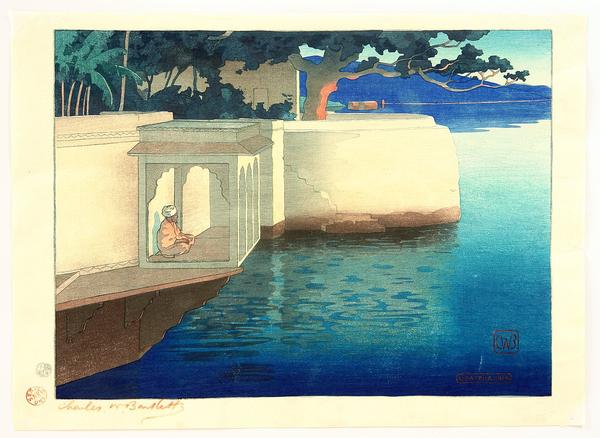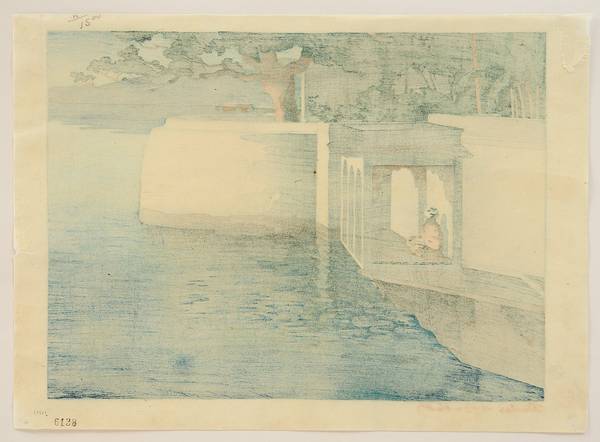| | |
| Artist: | Bartlett Charles |
| Title: | Udaipur - India |
| Series: | India Series |
| Date of first edition?: | 1916 |
| Publisher (first edition)?: | Watanabe Shozaburo — 渡辺 |
| Publisher (this edition)?: | Watanabe Shozaburo — 渡辺 |
| Medium (first edition): | Woodblock |
| Medium (this edition): | Woodblock |
| Format (first edition): | Oban
|
| Format (this edition): | Oban |
| DB artwork code: | 44927 |
| Notes (first edition)?: |
| It is interesting to note that Bartlett commissioned (and paid for) Watanabe to publish his prints, as opposed to Watanabe inviting Bartlett to be an artist for Watanabe. Because of this, Bartlett maintained full control of the publishing process and retained all the woodblocks, which are still located in Hawaii even to this day.
Title Udaipur - India
rare before Kanto Earthquake - hand signed
Artist Charles William Bartlett 1860-1940
Description "Udaipur". It is also known as the City of Lakes, the "Venice of the East", in the state of Rajasthan in western India.
Crystal clear blue water and the intricate shades reflect the serene atmosphere in the hot afternoon.
From "India Series" which had Initially a 6-print portfolio starting in 1916. The popular series was continued until 1926 totaling 26 prints.
Signature "CWP" on the lower right. "Charles W. Bartlett" hand signed on the lower margin.
Dated 1916.
Publisher Watanabe.
Medium/Technique Woodblock print.
Note Watanabe 10mm round seal.
Width Item 13.6 inches = 34.5 cm
Height Item 9.8 inches = 25.0 cm
|
|
| Notes (this edition)?: |
| The following information was taken from the original web listing of this artwork. Note that there may be some inaccuracies:
Title Udaipur - India
rare before Kanto Earthquake - hand signed
Artist Charles William Bartlett 1860-1940
Description "Udaipur". It is also known as the City of Lakes, the "Venice of the East", in the state of Rajasthan in western India.
Crystal clear blue water and the intricate shades reflect the serene atmosphere in the hot afternoon.
From "India Series" which had Initially a 6-print portfolio starting in 1916. The popular series was continued until 1926 totaling 26 prints.
Signature "CWP" on the lower right. "Charles W. Bartlett" hand signed on the lower margin.
Dated 1916.
Publisher Watanabe.
Medium/Technique Woodblock print.
Impression Excellent.
Colors Excellent.
Condition Excellent - Very good ... Margins nominally soiled. Several thin areas and missing spots on the margins.
Note Watanabe 10mm round seal.
Width Item 13.6 inches = 34.5 cm
Height Item 9.8 inches = 25.0 cm |
|
| Artist Bio: |
Charles William Bartlett (1860-1940) was one of the first artists to work with the publisher Watanabe Shozaburo. Bartlett studied at the Royal Academy in London and at Academie Julian in Paris. Until his travels to Japan, Ceylon, Indonesia, and China in 1913, Bartlett worked primarily as a landscape and genre painter. In 1915 he met famous print publisher Watanabe, with whom he collaborated on the publication of a number of "shin hanga" style colour woodblock prints during the next decade, using Watanabe's studio to carve and create his own woodblocks. Bartlett designed 38 woodblock prints for Watanabe, beginning in 1916 and lasting through 1925. Twenty-two of these prints were produced within the first year, many with the date 1916 carved into the key block. The first series of prints consisted of six Indian scenes plus a cover print of the Taj Mahal. This was followed by a series of six Japanese scenes. Many of Bartlett's prints and etchings were scenes from his travels through Southeast Asia, China, and later Hawaii. After 1917, Bartlett settled in Hawaii where he remained for the rest of his life.
It is little known that in actual fact Bartlett commissioned Watanabe to publish his 38 scenes, rather than being an artist working for Watanabe, and from his base in Hawaii Bartlett held a very tight reign over Watanabe's production of each scene, requesting numerous fine colour changes for each scene. Because each of the scenes were commissioned and thus paid for by Bartlett , he maintained ownership of all the woodblocks, which were shipped back to Hawaii after each edition and are still kept in Hawaii even to this day.
|
|



